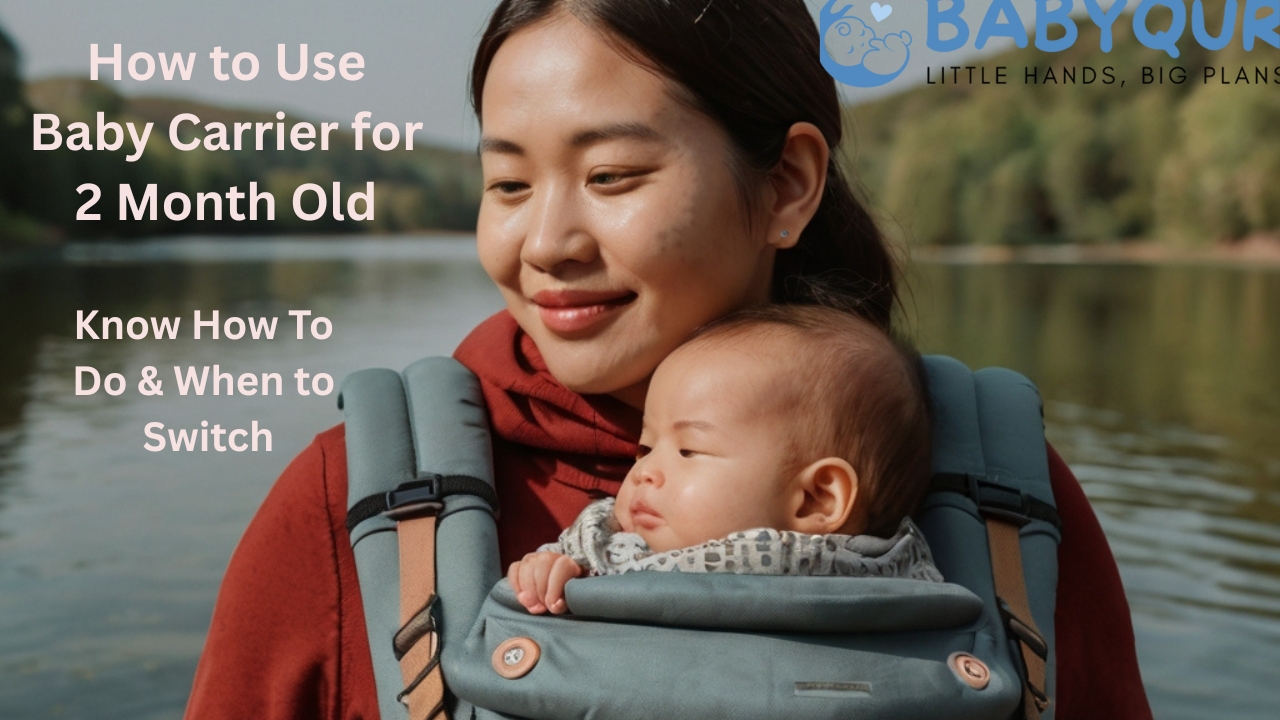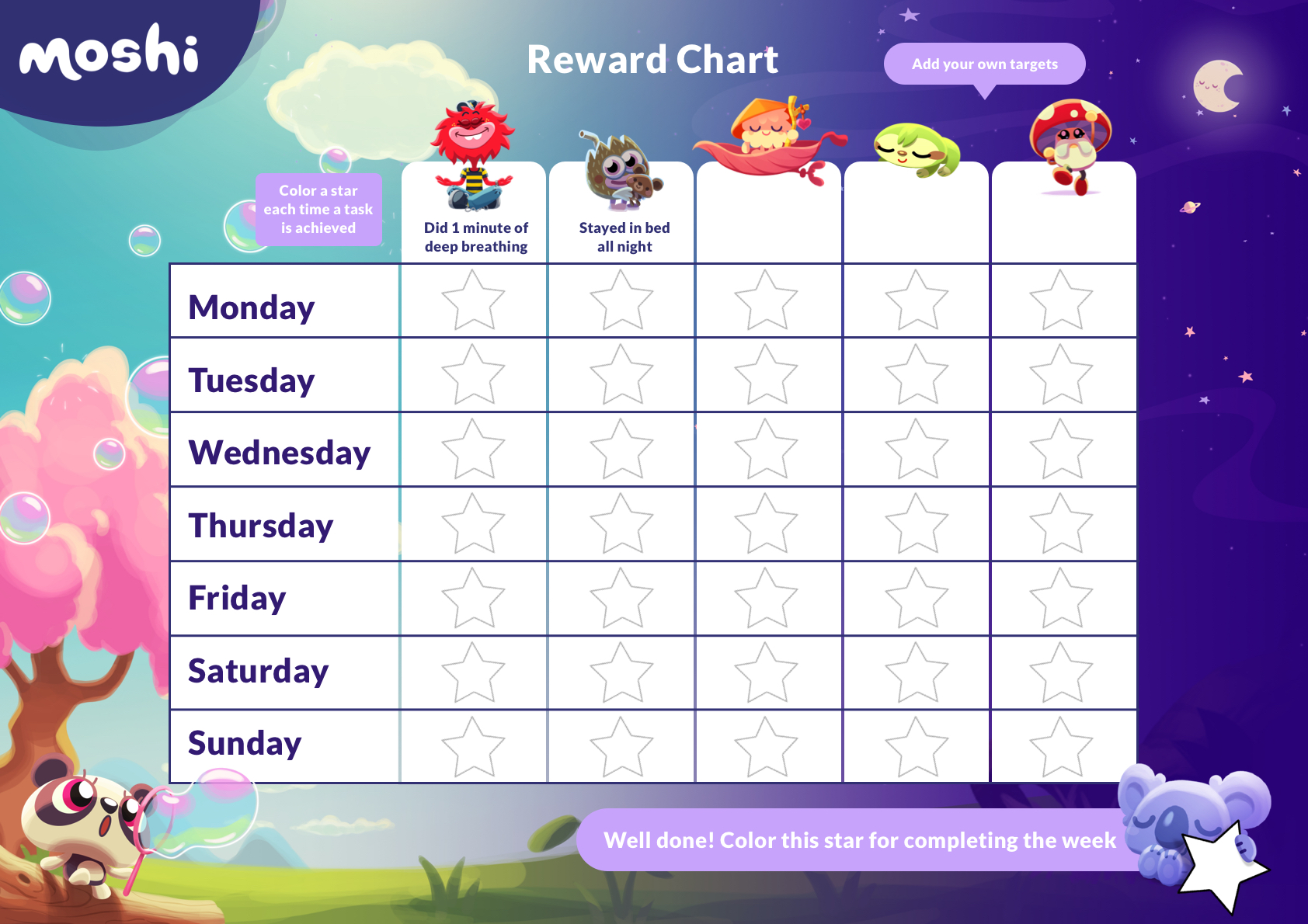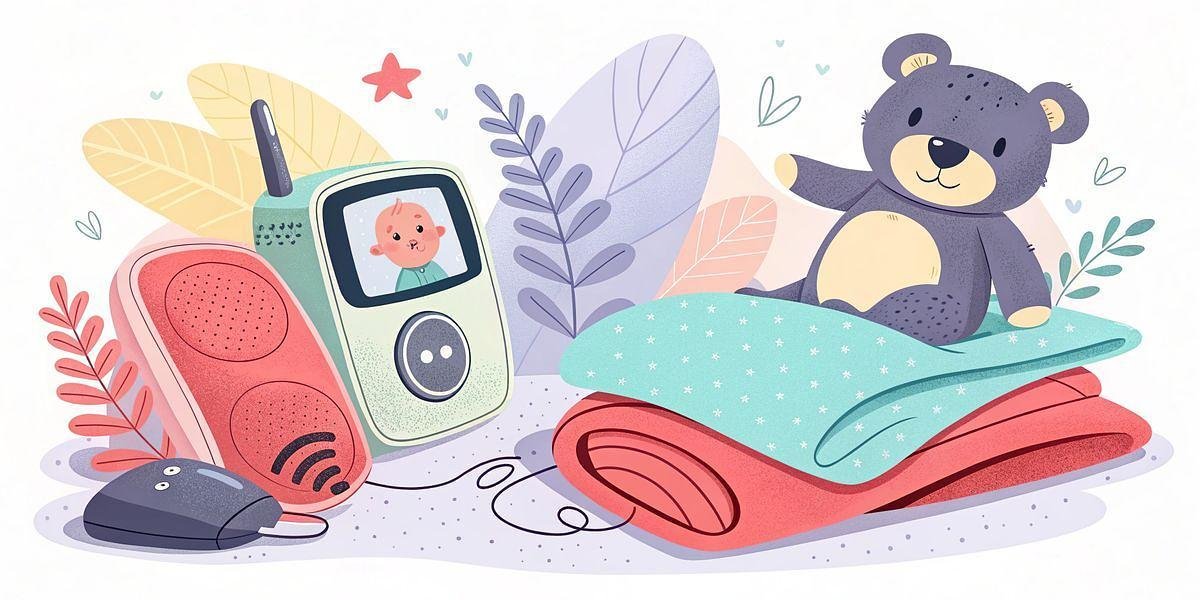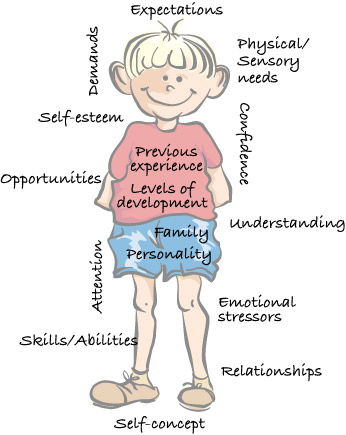Welcoming a new baby into your life is a joyous occasion, but it often comes with many questions and concerns. As a parent, you want the best for your little one, and one of those concerns might be how to safely and comfortably carry your 2-month-old baby.
You’ve probably heard about the benefits of baby carriers, from bonding to convenience, but the thought of using one might seem daunting. Imagine going about your day hands-free, all while keeping your baby snug and close. This guide is here to make that feel simple and doable.
By the end of this article, you’ll feel ready and confident to use a baby carrier effectively with your 2-month-old, with safety, comfort, and connection at the center of every carry.
To use a baby carrier with a 2-month-old, choose a newborn-friendly, inward-facing carrier, support the head and neck, and keep the legs in a hip-healthy “M” position. Your baby’s face should stay visible and kissable. Start with short sessions and offer frequent breaks for feeds, stretching, and play.
Key takeaways
- Use a newborn-ready, inward-facing carrier that meets your baby’s minimum weight and supports their head, neck, and spine.
- Keep your baby high, snug, and in the “M-position,” with their face visible, nose and mouth uncovered, and chin off their chest.
- Begin with 15–20 minute sessions and give breaks at least every one to two hours so your baby can stretch, move, and play on a flat surface.
Choosing the right baby carrier
Choosing the right baby carrier for a 2-month-old can feel overwhelming. It’s crucial to find a carrier that keeps your baby safe and comfortable and that feels good on your body too. Different carriers suit different needs and lifestyles, so a little comparison goes a long way.
Understanding baby carrier types
There are several types of baby carriers. Wraps are long pieces of fabric that you tie around your body for a snug, custom fit. Slings hang over one shoulder and can be quick to put on. Soft structured carriers use padding, straps, and buckles to give more built-in support and are often easier for beginners.
Prioritizing comfort and safety
Comfort is key for both you and your baby. Look for soft, breathable materials and padding at the shoulders and waist to spread your baby’s weight. For a 2-month-old, choose a carrier labeled as newborn-ready and check that your baby meets the minimum weight requirement. Always follow the manufacturer’s instructions for the newborn position.
Considering adjustability and fit
Adjustability helps the carrier fit your body and your baby’s changing size. Straps, waistbelts, and seat width adjustments allow you to center your baby’s weight and reduce strain on your back. A carrier that fits well should feel snug and supportive without pinching or digging into your shoulders or hips.
Evaluating ease of use
If a carrier is fiddly, you’re less likely to use it. Look for clear instructions, simple buckles, and a design you can put on and take off by yourself. Practise a few times with a rolled towel or doll so that when you place your baby in, the motions feel familiar and calm.
Exploring material and durability
The fabric affects both comfort and durability. Cotton and linen are breathable and gentle against delicate skin. Check that stitching feels strong and that the carrier is machine washable or easy to spot-clean. Since carriers are used often, sturdy materials help them stand up to everyday life.
Checking for ergonomic design
Ergonomic carriers support healthy hip development by creating a deep seat that runs from knee to knee. Your baby’s knees should sit slightly higher than their bottom, forming a gentle “M” shape with the legs. Choosing a hip-healthy, ergonomic carrier can help protect developing hips while keeping your baby snug and supported.
Safety guidelines
When using a baby carrier for your 2-month-old, safety should be your top priority. Babies are delicate at this age, so small adjustments make a big difference. The right carrier and habits can keep your baby secure and give you more peace of mind.
At two months, your baby should always ride in an inward-facing front carry. This position keeps their airway easier to monitor, lets you support their head and neck, and helps you respond quickly to any changes in their breathing, color, or comfort.
Proper positioning
Think of the carrier as an extension of your arms. Your baby’s face should be visible at all times and close enough for you to kiss the top of their head without leaning forward. Their chin should never be pressed against their chest, and their nose and mouth must stay clear of fabric.
Secure fastening
Always double-check every clip, buckle, and tie before you start moving. Straps should feel snug but not painfully tight. A loose strap can shift your baby’s weight and increase the risk of slipping, while overly tight straps can cause pressure points and discomfort for you and your little one.
Carrier material and temperature
Choose breathable fabrics that keep your baby cool and comfortable, especially in warm weather or crowded indoor spaces. Dress your baby in one light layer more than you’re wearing, then feel the back of their neck or chest to check if they’re too hot or too cold. Adjust clothing and carrier layers as needed.
Weight limitations and recalls
Every carrier lists a minimum and maximum weight range. Make sure your 2-month-old is within that range, including when using any infant insert. Using a carrier outside its limits can stress seams or buckles. It’s also wise to check your carrier model for safety recalls or manufacturer advisories from time to time.
Helpful expert resources
For extra reassurance, you can review baby carrier safety tips from trusted organizations, such as the American Academy of Pediatrics’ HealthyChildren.org guide to baby carriers or the International Hip Dysplasia Institute’s babywearing recommendations. These resources reinforce the importance of inward-facing, hip-healthy positioning and airway safety.
Proper positioning techniques
Proper positioning in a baby carrier keeps your 2-month-old safe and comfortable. At this age, your baby’s body is still developing, so good support for the head, spine, and hips matters. Positioning also affects how well you can see and respond to your baby’s cues.
Head and neck support
Newborns don’t yet have strong neck muscles. Use the carrier’s built-in head support or an approved infant insert to keep your baby’s head from flopping backward or forward. Their head should rest close enough to kiss, and you should be able to see their face with a quick glance downward.
Hip and leg positioning (the “M-position”)
Aim for an “M-position” with your baby’s legs. Their knees should be higher than their bottom, with thighs supported from knee to knee by the carrier seat. This helps keep the hips in a natural, flexed position. Avoid letting your baby’s legs dangle straight down with all the pressure on the crotch.
Spinal alignment
Your baby’s spine should follow its natural gentle curve. The carrier’s panel should hug their back so there’s no slumping or hunching. If you lean forward, your baby shouldn’t peel away from your chest. A firm, snug fit usually indicates that the panel is giving enough support.
Visibility and comfort for both of you
Your baby’s face must remain uncovered and in view. Once they are settled, check that their hips, legs, and feet are comfortable and not pinched by fabric. Adjust the carrier so that your shoulders and lower back feel supported too—a well-fitted carrier should feel like your baby is part of your center of gravity, not pulling you forward.
Adjusting for comfort
A well-adjusted carrier supports your baby’s developing body and protects your own back and shoulders. Taking a few extra seconds to tweak the fit can turn a fussy, uncomfortable carry into a calm, hands-free snuggle.
Check the seat width
Make sure the seat is wide enough to support your baby’s hips and legs in the M-position. Their knees should be slightly higher than their bottom, with the fabric reaching to the backs of their knees but not past them. Some soft structured carriers have adjustable seats—use the narrowest setting that still supports from knee to knee.
Adjust the straps
Shoulder straps should feel snug and supportive without digging in. If your shoulders or neck ache, tighten the waistbelt first to bring more weight onto your hips, then fine-tune the shoulder straps. A chest clip (if included) can also help stabilize the straps and reduce strain.
Position the head support
Your 2-month-old needs consistent head and neck support, especially if they fall asleep in the carrier. Use the headrest or a manufacturer-approved insert to stabilize their head in a neutral position. If the panel can be folded or snapped, choose the setting that supports the head without covering the face.
Ensure visibility
Your baby should sit high enough that you can easily kiss the top of their head. If you have to bend down to see them, tighten the carrier. If the carrier rides up too close to your throat, lower or adjust the waistbelt. Small tweaks can quickly improve both safety and comfort.
Monitor your own comfort
Comfort for you is part of safety too. If the carrier feels off-balance, pulls on one side, or strains your lower back, pause and adjust. Try redistributing weight with the waistbelt, changing strap position, or taking a short break. A comfortable parent is better able to respond calmly to a baby’s needs.
Wearing duration recommendations
Wearing a baby carrier with a 2-month-old is meant to be flexible and responsive. There is no single “perfect” number of minutes that works for every baby. Instead, focus on short, comfortable sessions, regular breaks, and your baby’s cues.
Understanding your baby’s cues
Watch your baby’s behavior to guide how long they stay in the carrier. Signs like fussiness, arching, squirming, or sweaty skin mean it’s time for a break. If your baby seems relaxed, breathing easily, and content, they’re likely comfortable to stay in the carrier a bit longer.
Short sessions at first
Start with short sessions of about 15–20 minutes so your baby can get used to the feel of the carrier. Gradually increase the time as both of you become more comfortable, always keeping an eye on your baby’s breathing, color, and temperature.
Maximum time in one stretch
As a general guideline, many experts suggest offering a break at least every one to two hours. During breaks, take your baby out of the carrier for a change of position, tummy time, stretching, and play. There is no strict daily maximum—what matters most is variety of positions and regular opportunities to move.
Consider the weather
In hot weather, shorten sessions and choose lighter fabrics, since your body heat adds to your baby’s temperature. In colder weather, dress your baby in layers rather than thick snowsuits, which can affect strap tension. Always check your baby’s neck or chest, not hands or feet, to judge their temperature.
Alternate with other activities
Balance carrier time with floor play, supervised tummy time, and cuddles in your arms or in a stroller. For more ideas, you can explore guides like how to keep your baby entertained in a stroller or how to make the stroller more comfortable so your baby gets a variety of safe, supported positions.
Cleaning and maintenance
Cleaning and maintaining your baby carrier keeps it safe, hygienic, and comfortable. Regular care helps the carrier last longer and makes it easier to spot wear and tear before it becomes a problem.
Check manufacturer’s instructions
Always read the manufacturer’s care label before washing. Some carriers can go straight into the washing machine, while others require more delicate handwashing. Following the instructions helps prevent shrinking, fading, or damaging the padding and buckles.
Spot cleaning for quick fixes
For small spills or spit-up, wipe the area gently with a damp cloth and a bit of mild soap if needed. Avoid harsh chemicals or bleach, which can irritate your baby’s skin and weaken the fabric fibers over time.
Machine washing guidelines
If your carrier is machine washable, place it in a pillowcase or laundry bag to protect straps and buckles. Use a gentle cycle with cold water and a mild detergent. Skip fabric softeners, which can coat the fibers and affect how the fabric supports your baby. Air-dry flat or on a line to maintain shape.
Hand washing for delicate carriers
For delicate fabrics, fill a basin with cold water and mild detergent. Gently agitate the carrier in the water, paying extra attention to heavily used areas like the seat and straps. Rinse thoroughly until the water runs clear, then press out excess water and lay the carrier flat to dry in a shaded area.
Regular inspections for wear and tear
Periodically check all parts of your carrier—straps, seams, buckles, snaps, and zippers. Look for fraying, loose stitching, cracks, or broken pieces. If you notice damage, stop using the carrier until it’s repaired or replaced so you can keep your baby safe on every outing.
FAQs
Is a baby carrier safe for a 2-month-old?
Yes, a baby carrier can be safe for a 2-month-old when it is newborn-ready, supports the head and neck, and is used in an inward-facing front carry. Always check weight limits and watch your baby’s breathing, color, and comfort.
How do I position my 2-month-old in a carrier?
Keep your baby high and snug on your chest, with their face visible and close enough to kiss. Support the head and neck, hold the spine in a gentle curve, and position the legs in an M-shape with knees higher than the bottom.
Can baby carriers affect my baby’s hip or spine development?
A well-designed, ergonomic carrier that supports the thighs from knee to knee and keeps the spine naturally curved is considered hip-healthy. Problems are more likely when legs dangle straight down or the baby slumps without proper support.
How long can my 2-month-old stay in a carrier?
Many experts suggest offering a break at least every one to two hours. Start with short 15–20 minute sessions, then increase as your baby tolerates it, making sure they also get tummy time, floor play, and other positions each day.
Which type of carrier is best for a 2-month-old?
Newborn-friendly wraps, ring slings, and soft structured carriers with an infant insert can all work. Look for a carrier labeled newborn-ready that supports an M-position, meets your baby’s weight minimum, and feels comfortable on your shoulders and hips.
Can my 2-month-old face outward in the carrier?
No. At two months, babies should ride inward-facing only. Outward-facing positions are usually recommended later, once your baby has strong head and neck control and meets your carrier’s age and weight guidelines.
Glossary
- M-position
- A hip-healthy position where your baby’s knees are higher than their bottom, thighs are supported from knee to knee, and the legs form a gentle “M” shape.
- Inward-facing carry
- A carrier position where your baby faces your chest, not the outside world, so you can easily monitor their airway and support their head and neck.
- Newborn-ready carrier
- A carrier that is designed to safely support newborns and small infants, often with an insert or adjustable seat for extra head, neck, and hip support.
Related articles







